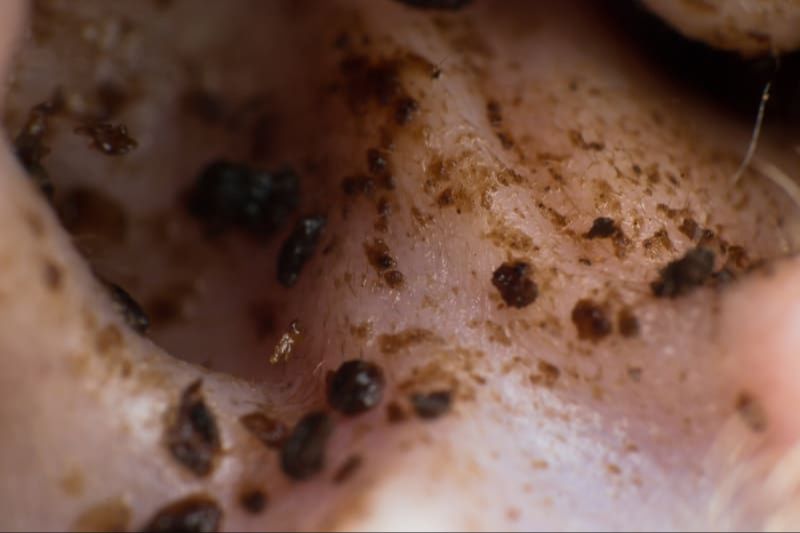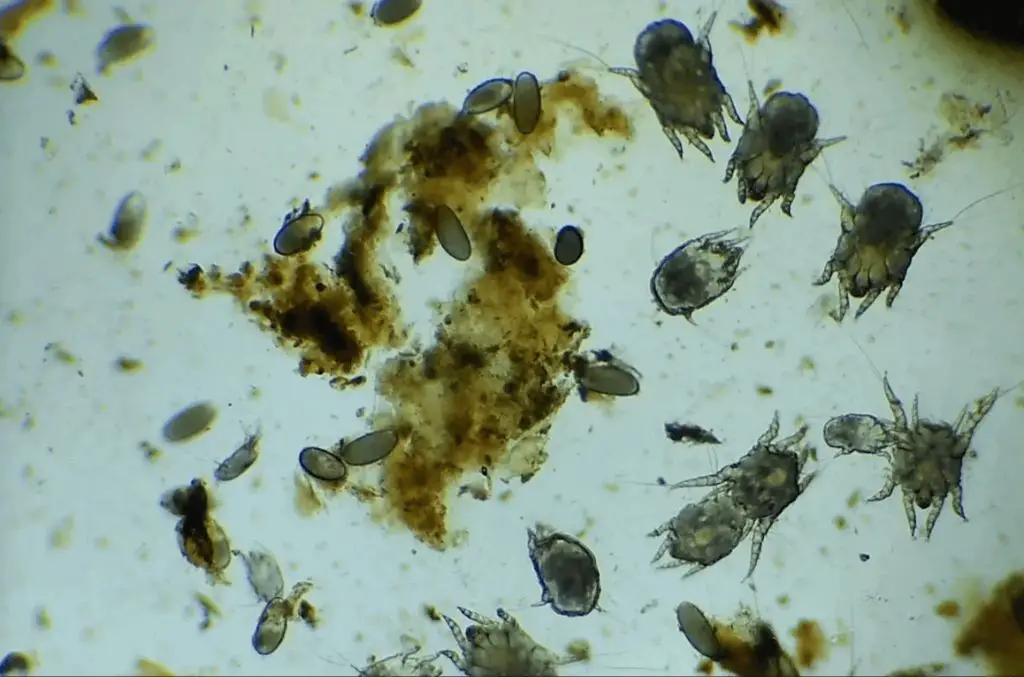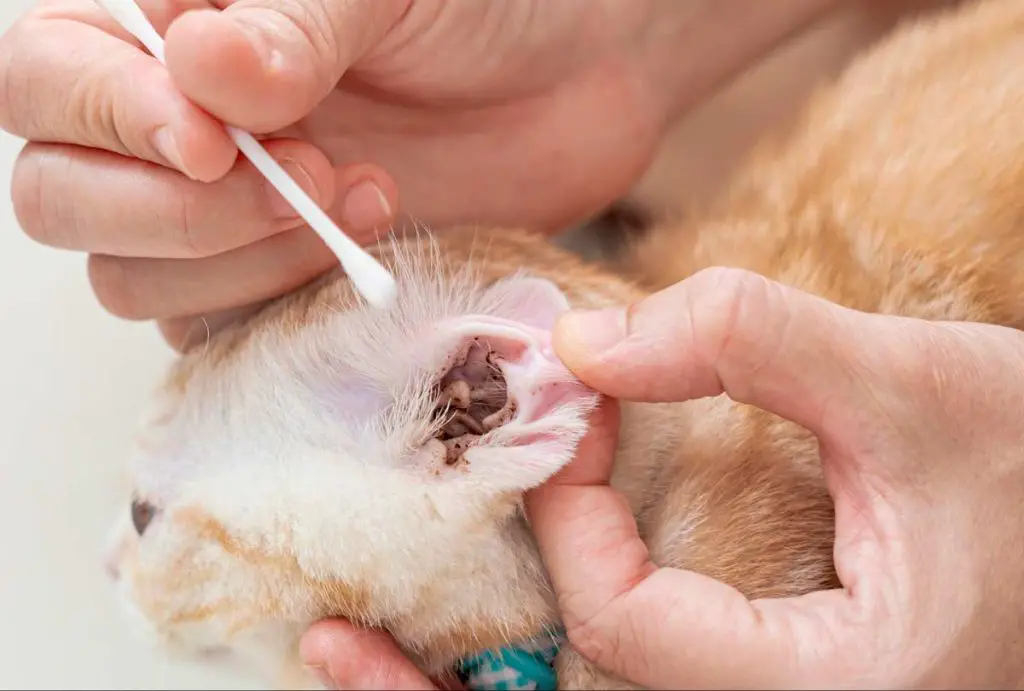What are ear mites in cats?
Ear mites, known scientifically as Otodectes cynotis, are microscopic parasites that live in the ear canals of cats, dogs, and other animals. They are tiny arachnids, related to spiders and ticks, that feed on ear wax and oils inside the ear canal (1).
Under a microscope, ear mites appear white and can just barely be seen with the naked eye. An adult ear mite is about 0.3-0.5mm long, with eight legs (2). They have round bodies and can move quickly which allows them to hide deep inside the ear canal.
Ear mites live their entire lifecycle inside the ear canal. The female mite will lay eggs which hatch into larvae after 3-4 days. The larvae mature into nymphs and then into adults after about 3 weeks. The adults mate and continue the lifecycle. Ear mites can survive 2-3 weeks without a host (2).
(1) https://www.vet.cornell.edu/departments-centers-and-institutes/cornell-feline-health-center/health-information/feline-health-topics/ear-mites-tiny-critters-can-pose-major-threat
(2) https://vcahospitals.com/know-your-pet/ear-mites-otodectes-in-cats-and-dogs
Common symptoms of ear mites

Cats with ear mites often show clear symptoms of irritation and discomfort. Some of the most common symptoms of an ear mite infestation include:
– Black debris resembling coffee grounds: Ear mites live in the ear canal and feed on ear wax and oils. The mites’ waste appears as blackish/brownish granules that look like ground coffee. This dark debris is a telltale sign of an ear mite infestation.
– Head shaking and scratching: The irritation caused by ear mites and their waste products leads to constant head shaking and scratching at the ears. Cats may shake their head repeatedly and use their paws to scratch at their ears in an attempt to relieve itchiness.
– Reddened ears: The irritation and inflammation caused by ear mites can lead to red, swollen ears. The constant scratching and head shaking can also cause scrapes and abrasions on the ear surface.
How do cats get ear mites?
Ear mites are highly contagious parasites that are easily passed between cats through close contact. The mites quickly spread from infected cats to others through activities like play, mutual grooming, and snuggling. The Lake Cross Veterinary Hospital notes that mother cats can also pass ear mites to their nursing kittens.
According to the Cornell Feline Health Center, ear mites are “extremely contagious, moving from one cat to another on close contact.” Once ear mites infest one cat in a home or neighborhood, they can quickly spread to other felines through direct contact.
In summary, ear mites easily pass between cats through close interactions. Kittens also frequently get infested from their mothers. Maintaining awareness and promptly treating any infections can help control the spread of ear mites among cats in a household or community.
Diagnosing ear mites

If your cat is showing symptoms of an ear mite infestation, the first step is to take them to the veterinarian for a diagnosis. The vet will perform a physical examination of your cat’s ears using an otoscope to look for signs of irritation and the presence of mites or eggs. According to Matthews Veterinary Clinic, “An otoscope allows your veterinarian to look down into the vertical ear canal for signs of inflammation, discharge, or ear mites” (https://www.matthews.carolinavet.com/site/pet-health-blog/2022/05/15/cat-ear-mites).
To confirm the presence of ear mites, the vet may take a sample of the material from the ear canal using a cotton swab. This sample can then be examined under a microscope to look for ear mites, eggs, and mite debris. As Small Door Veterinary explains, “Then your veterinarian may recommend taking a skin scraping or ear swab to look for signs of ear mites, like the mites themselves and their eggs. If ear mites or eggs are seen under the microscope, then your cat has ear mites” (https://www.smalldoorvet.com/learning-center/medical/ear-mites-in-cats/). Microscopic examination is the most definitive way to diagnose an ear mite infection.
Treating ear mites
Treating ear mites usually involves thoroughly cleaning the cat’s ears and using medicated ear drops or oral medications. The goal is to kill the mites and allow the cat’s ears to heal.
Veterinarians often recommend using ear cleaning solution or mineral oil to gently flush wax and debris out of the ear canal. This helps remove the environment where mites can thrive.[1] A cotton ball can be used to carefully wipe visible wax and black debris from the ear flap and canal.
Medicated ear drops containing ingredients like pyrethrins, fipronil, selamectin, or ivermectin are commonly prescribed. These products kill mites on contact and continued use helps eliminate newly hatched mites. Ear drops are applied directly into the ear canal for 7-30 days depending on the product. It’s important to follow dosage instructions carefully.[2]
Oral flea medications containing selamectin or ivermectin can also be prescribed to kill mites through the bloodstream. This treats infections deeper in the ear canal. Oral meds are given over several weeks.[3]
To fully eliminate ear mites, treatment must be continued as directed until new generations of mites are killed before they can reproduce again. Consult your veterinarian to determine the best treatment plan.
Preventing ear mites
There are a few key ways to help prevent your cat from getting ear mites:
Regular cleaning – Regularly cleaning your cat’s ears can help prevent buildup of ear wax and debris that ear mites feed on. Gently wipe the inside of your cat’s ears weekly with a cotton ball dampened with an ear cleaner recommended by your veterinarian. Be very gentle, never insert anything into the ear canal.
Avoid contact with infected cats – Since ear mites are highly contagious between cats, limiting your cat’s exposure to outdoor and stray cats who may have ear mites can reduce their chances of infection. This is especially important for young kittens.
Keep environment clean – Ear mites can survive for several days in the environment. Regularly wash your cat’s bedding and vacuum areas they frequent to remove any mites or eggs that may be present.
Discuss prevention with your vet – Your veterinarian can recommend monthly ear cleanings, prescription ear mite prevention medications, and flea/tick control products that may also repel ear mites. Implementing prevention measures recommended by your vet can help protect your cat.
While ear mites can’t always be completely prevented, taking key steps helps lower your cat’s chances of troublesome ear mite infestations.
Complications from ear mites
Ear mites can lead to complications if left untreated, including:

Ear infections: The inflammation and irritation caused by ear mites can enable bacterial and fungal infections to develop in the ear canal. These are known as otitis externa or media. Infections cause additional swelling, discharge, odor, and pain in the ears. Antibiotics or antifungal medication may be needed in addition to eliminating the mites. According to the Cornell Feline Health Center, “Secondary ear infections are a common sequel to ear mite infestation.”1
Damage to ear canal: If an ear mite infestation is allowed to persist untreated, the excessive itching and inflammation can lead to damage of the ear canal tissue and cartilage. This can cause thickening, hardening, narrowing, or scarring of the ear canal. Surgery may be required in severe cases to remove damaged tissue and restore normal ear canal openings and function. Keeping ear mites under control is important to avoid permanent ear damage in cats.2
Ear mite life cycle
The entire life cycle of an ear mite takes around 3 weeks to complete. It goes through the following stages:
Eggs
Adult female mites lay eggs in the ears of cats. The eggs are oval-shaped and take around 4 days to hatch into larvae.
Larvae
Larvae emerge from the eggs after 4 days. The larvae have 6 legs and are smaller than adult mites. They molt into a nymph stage after 5-7 days.
Nymphs
Nymphs resemble small adult mites but only have 8 legs instead of the adult’s 8 legs. They molt into adults after 5-8 days.
Adults
Adults mate and females lay more eggs to continue the life cycle. Adult mites can survive for up to 8 weeks. The females constantly produce eggs while living on the cat.
The entire life cycle from egg to adult takes approximately 3 weeks to complete under ideal conditions. Then the offspring repeat the cycle.
Source: https://vcahospitals.com/know-your-pet/ear-mites-otodectes-in-cats-and-dogs
Are ear mites contagious to humans?
Ear mites are not able to live on humans or other animals besides cats and ferrets. Ear mites are a species-specific parasite that requires feline hosts to complete their life cycle. Pines Meadow Veterinary Clinic notes that ear mites are not contagious to humans.

While humans cannot get ear mite infections from cats, the mites’ skin irritation may cause some temporary itchiness if human skin comes in close contact with the mites. However, the mites will die quickly once off the cat host and do not burrow into or live on human skin. Ear mites are not considered a zoonotic disease (a disease transmissible between animals and humans).
So while ear mites need cats and ferrets to survive, they pose no risk of contagious infection to human owners or family members. The mites cannot complete their life cycle or reproduce on humans or other animal species.
When to See a Vet
In most cases, cat ear mites can be effectively treated at home with medications prescribed by your veterinarian. However, you should take your cat to the vet if you notice any of the following:
- Persistent head shaking, scratching, or signs of discomfort after initial treatment
- No improvement in symptoms within 1-2 weeks of starting treatment (https://www.lakecross.com/site/blog-huntersville-vet/2022/05/30/cat-ear-mites)
- Discharge or odor coming from the ears
- Crusting around the outer ears
- Loss of balance or disorientation
- Redness or swelling of the outer or inner ear
- Bleeding from the ears
If your cat’s symptoms don’t improve with the initial round of treatment or the condition seems to get worse, contact your vet right away. Persistent head shaking or scratching after treatment could mean the mite infestation is still present and requires additional medication. Your vet may need to flush your cat’s ears or prescribe a stronger medication to fully eliminate the mites.
Left untreated, ear mites can lead to secondary bacterial or fungal infections of the ear canal, so it’s important to follow up with your vet if you don’t see improvement. With prompt treatment and care, ear mites can usually be managed quickly and effectively.
